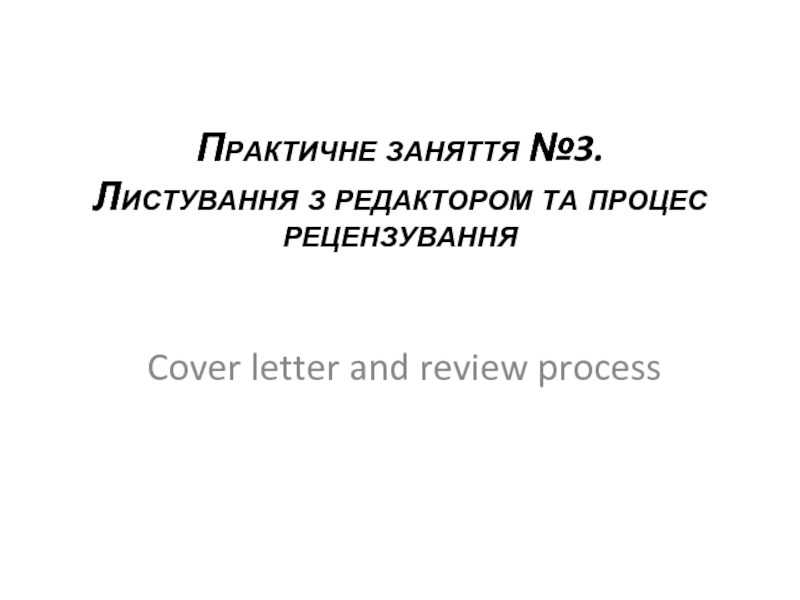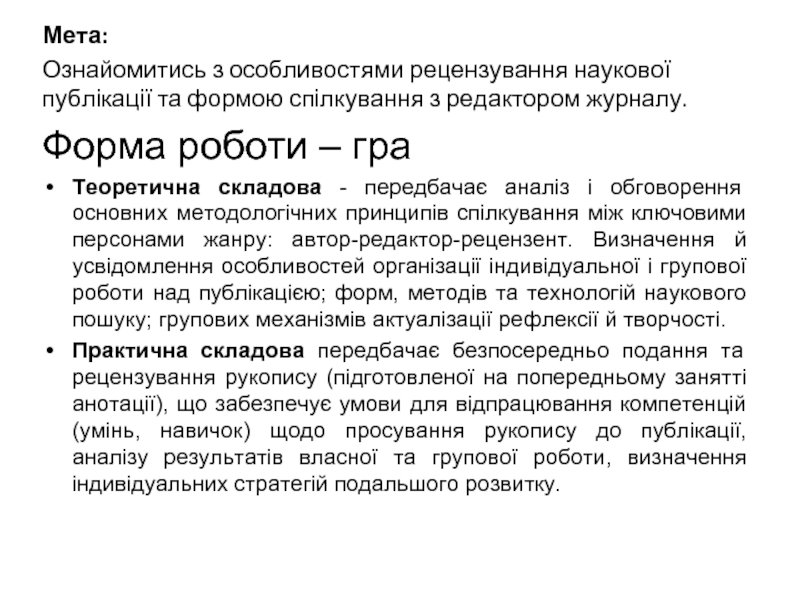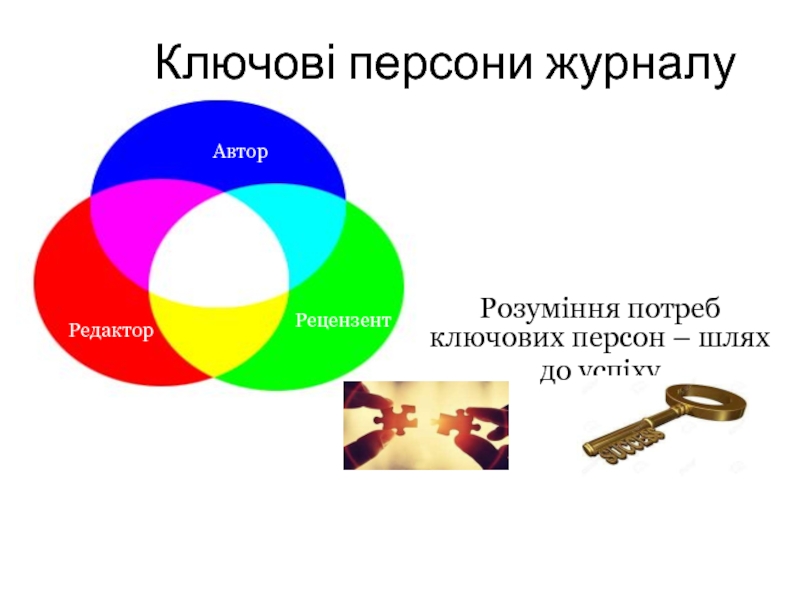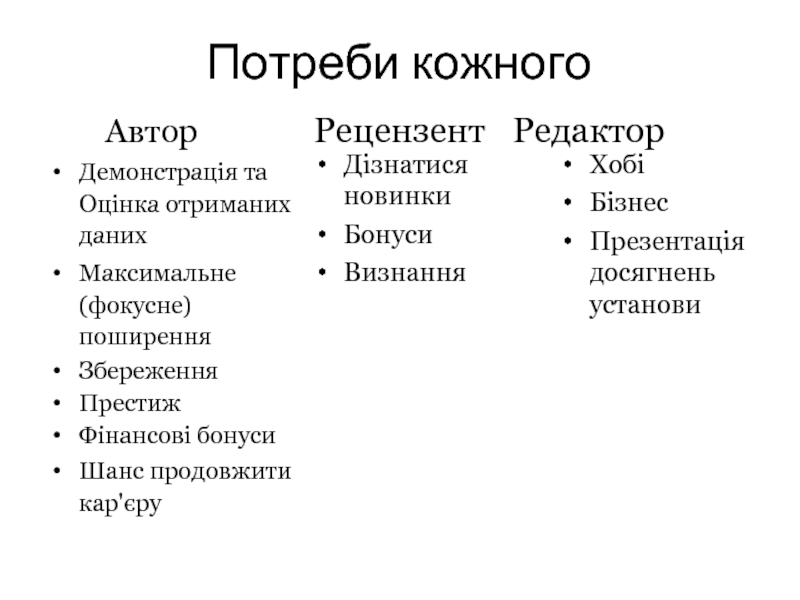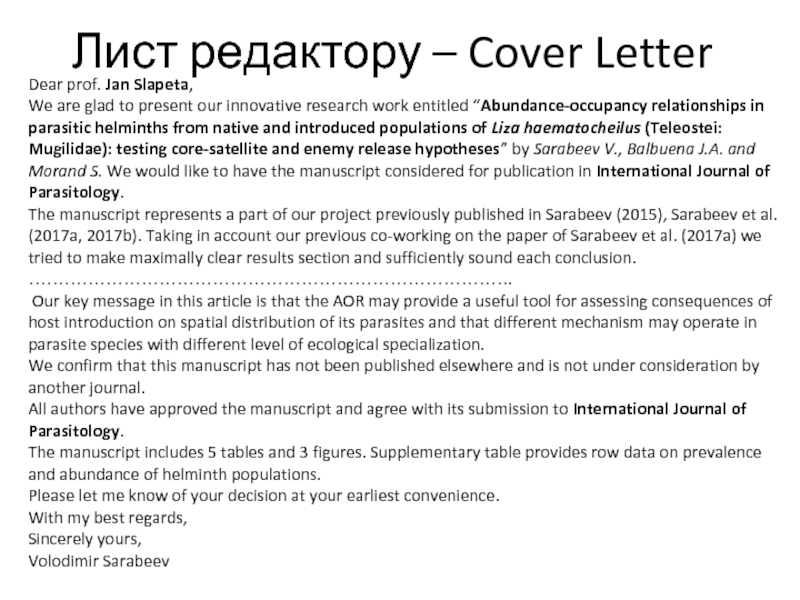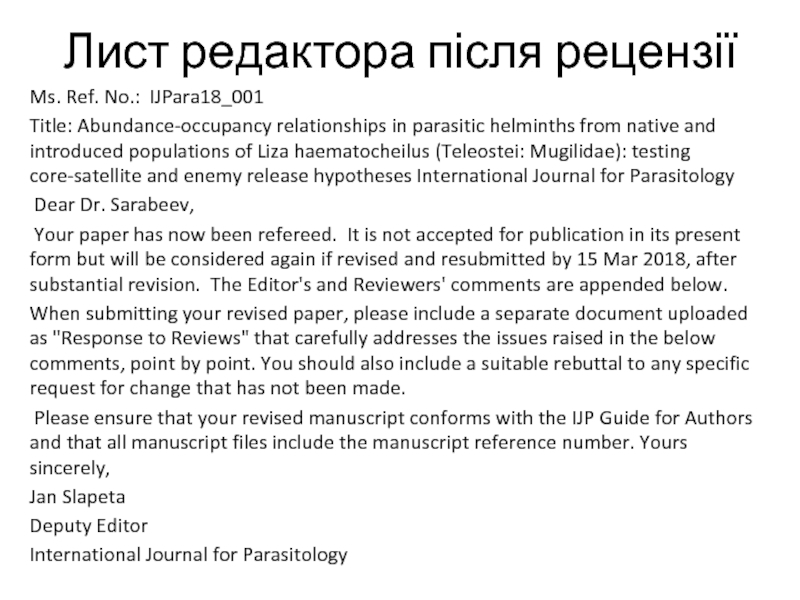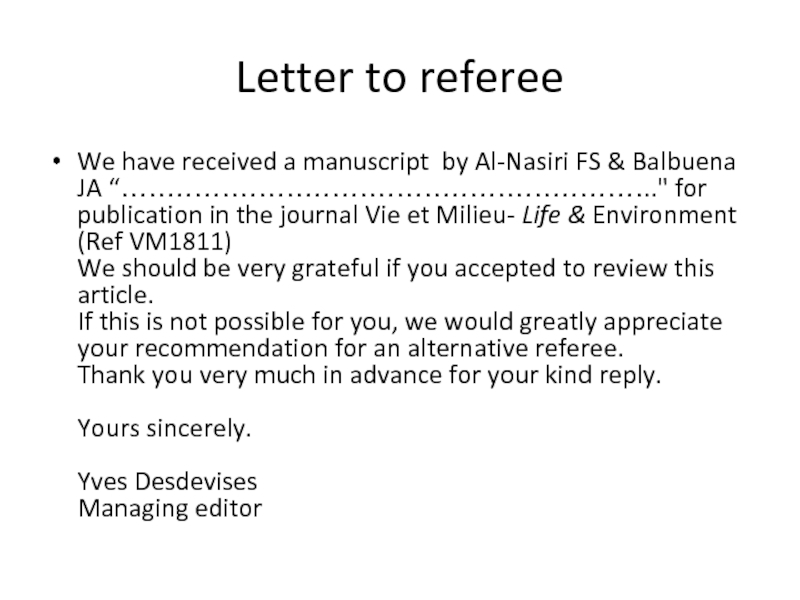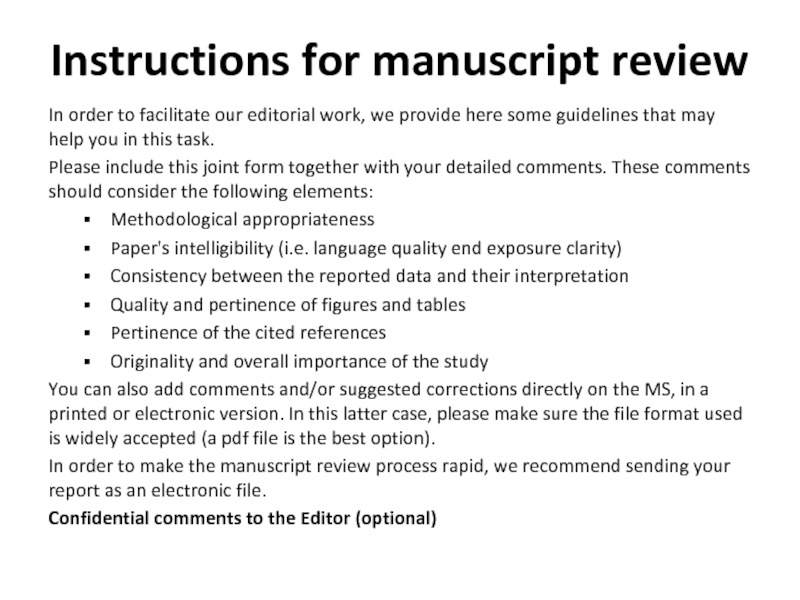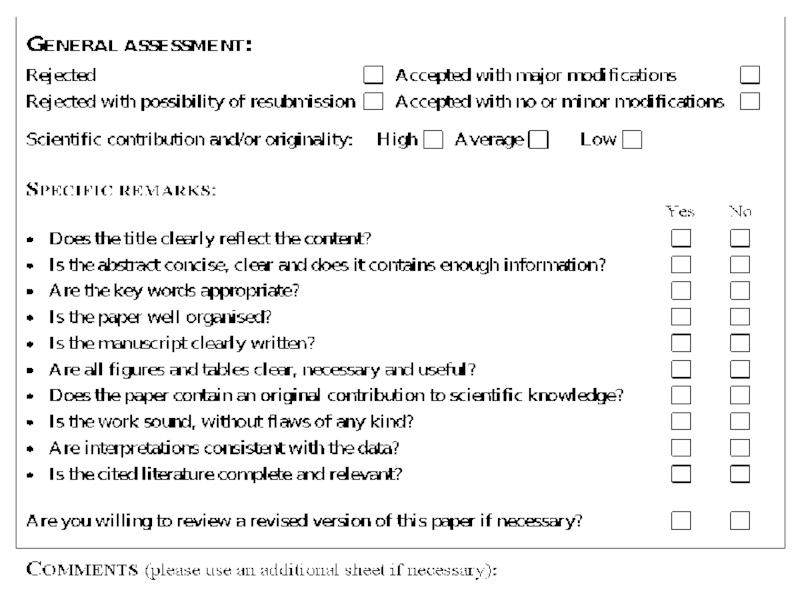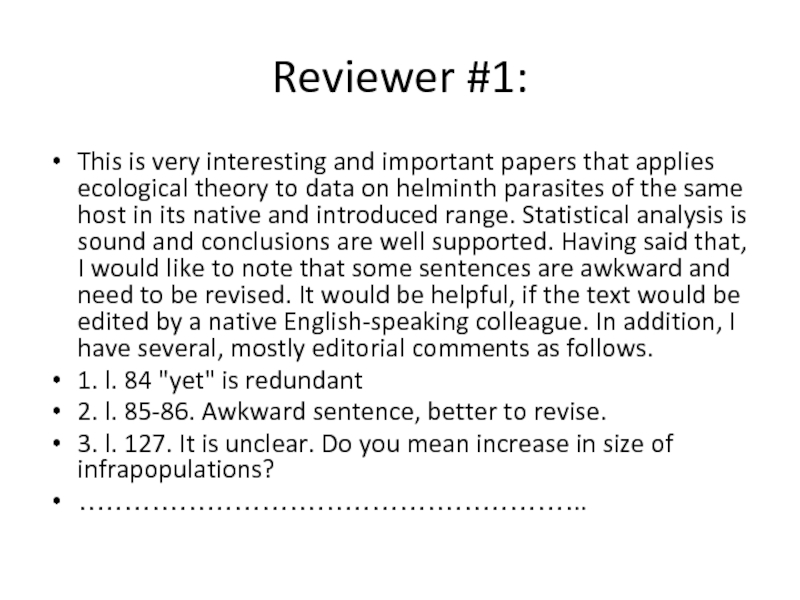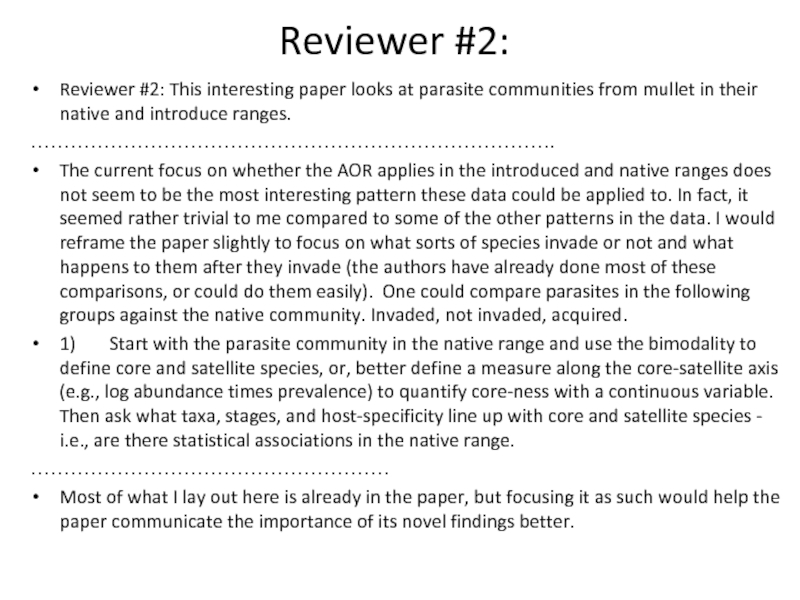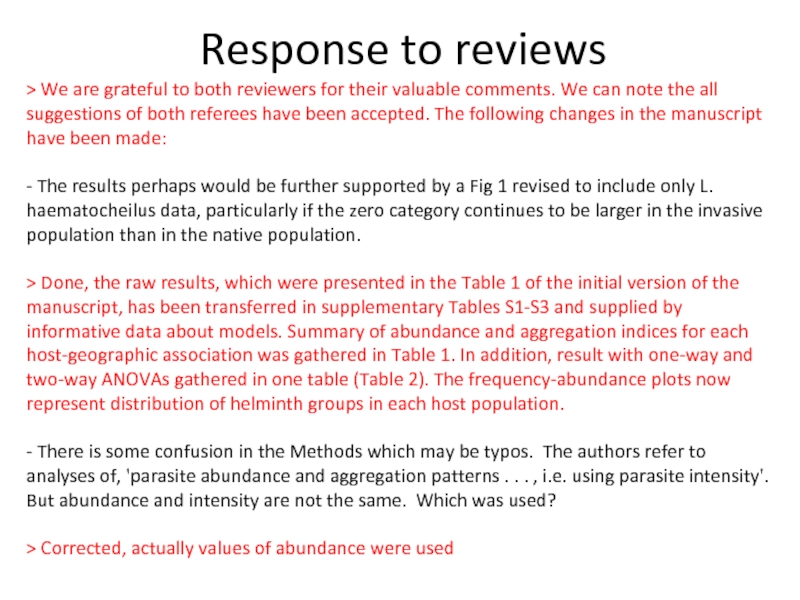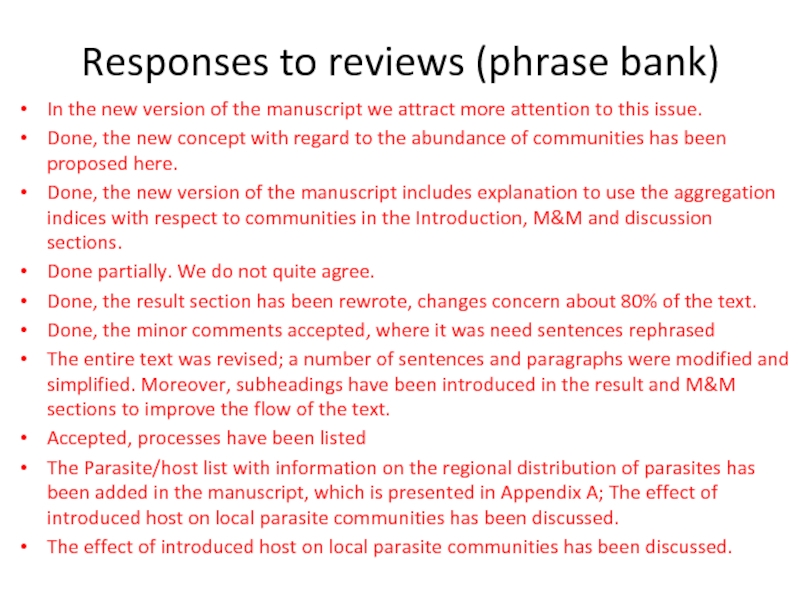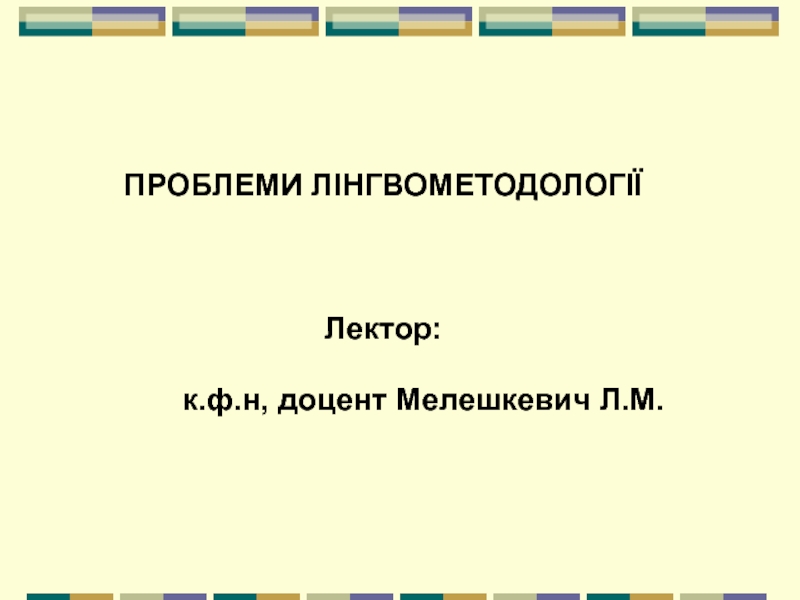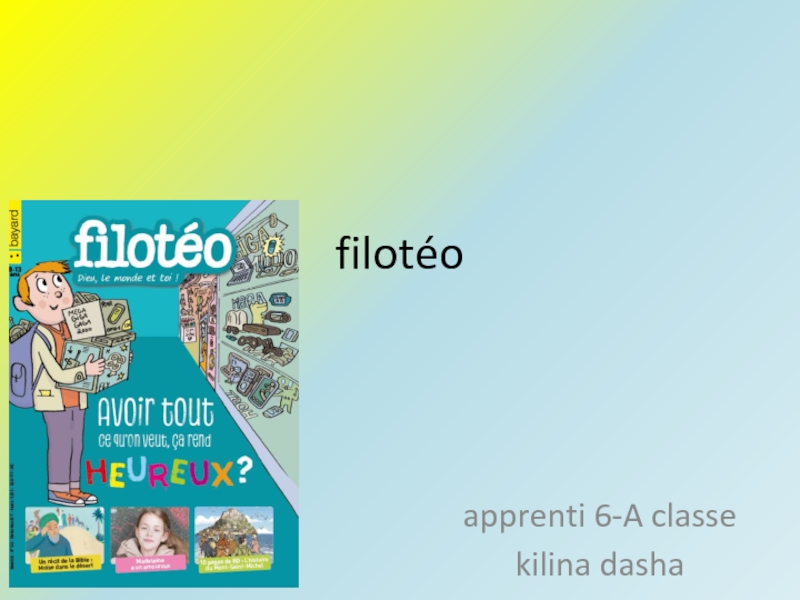review process
- Главная
- Разное
- Дизайн
- Бизнес и предпринимательство
- Аналитика
- Образование
- Развлечения
- Красота и здоровье
- Финансы
- Государство
- Путешествия
- Спорт
- Недвижимость
- Армия
- Графика
- Культурология
- Еда и кулинария
- Лингвистика
- Английский язык
- Астрономия
- Алгебра
- Биология
- География
- Детские презентации
- Информатика
- История
- Литература
- Маркетинг
- Математика
- Медицина
- Менеджмент
- Музыка
- МХК
- Немецкий язык
- ОБЖ
- Обществознание
- Окружающий мир
- Педагогика
- Русский язык
- Технология
- Физика
- Философия
- Химия
- Шаблоны, картинки для презентаций
- Экология
- Экономика
- Юриспруденция
Листування з редактором та процес рецензування презентация
Содержание
- 1. Листування з редактором та процес рецензування
- 2. Мета: Ознайомитись з особливостями рецензування наукової
- 3. Ключові персони журналу Автор Рецензент Редактор
- 4. Потреби кожного Автор Демонстрація та Оцінка отриманих
- 5. Лист редактору – Cover Letter Dear prof.
- 6. Лист редактора після рецензії Ms. Ref. No.:
- 7. Letter to referee We have received a
- 8. Instructions for manuscript review In order to
- 10. Reviewer #1: This is very interesting and
- 11. Reviewer #2: Reviewer #2: This interesting paper
- 12. Cover letter after review Ms. Ref. No.:
- 13. Response to reviews > We are grateful
- 14. Responses to reviews (phrase bank) In the
Слайд 2Мета:
Ознайомитись з особливостями рецензування наукової публікації та формою спілкування з
редактором журналу.
Форма роботи – гра
Теоретична складова - передбачає аналіз і обговорення основних методологічних принципів спілкування між ключовими персонами жанру: автор-редактор-рецензент. Визначення й усвідомлення особливостей організації індивідуальної і групової роботи над публікацією; форм, методів та технологій наукового пошуку; групових механізмів актуалізації рефлексії й творчості.
Практична складова передбачає безпосередньо подання та рецензування рукопису (підготовленої на попередньому занятті анотації), що забезпечує умови для відпрацювання компетенцій (умінь, навичок) щодо просування рукопису до публікації, аналізу результатів власної та групової роботи, визначення індивідуальних стратегій подальшого розвитку.
Форма роботи – гра
Теоретична складова - передбачає аналіз і обговорення основних методологічних принципів спілкування між ключовими персонами жанру: автор-редактор-рецензент. Визначення й усвідомлення особливостей організації індивідуальної і групової роботи над публікацією; форм, методів та технологій наукового пошуку; групових механізмів актуалізації рефлексії й творчості.
Практична складова передбачає безпосередньо подання та рецензування рукопису (підготовленої на попередньому занятті анотації), що забезпечує умови для відпрацювання компетенцій (умінь, навичок) щодо просування рукопису до публікації, аналізу результатів власної та групової роботи, визначення індивідуальних стратегій подальшого розвитку.
Слайд 4Потреби кожного
Автор
Демонстрація та Оцінка отриманих даних
Максимальне (фокусне) поширення
Збереження
Престиж
Фінансові бонуси
Шанс продовжити кар'єру
Дізнатися
новинки
Бонуси
Визнання
Рецензент Редактор
Хобі
Бізнес
Презентація
досягнень установи
Слайд 5Лист редактору – Cover Letter
Dear prof. Jan Slapeta,
We are glad to
present our innovative research work entitled “Abundance-occupancy relationships in parasitic helminths from native and introduced populations of Liza haematocheilus (Teleostei: Mugilidae): testing core-satellite and enemy release hypotheses” by Sarabeev V., Balbuena J.A. and Morand S. We would like to have the manuscript considered for publication in International Journal of Parasitology.
The manuscript represents a part of our project previously published in Sarabeev (2015), Sarabeev et al. (2017a, 2017b). Taking in account our previous co-working on the paper of Sarabeev et al. (2017a) we tried to make maximally clear results section and sufficiently sound each conclusion.
……………………………………………………………………….
Our key message in this article is that the AOR may provide a useful tool for assessing consequences of host introduction on spatial distribution of its parasites and that different mechanism may operate in parasite species with different level of ecological specialization.
We confirm that this manuscript has not been published elsewhere and is not under consideration by another journal.
All authors have approved the manuscript and agree with its submission to International Journal of Parasitology.
The manuscript includes 5 tables and 3 figures. Supplementary table provides row data on prevalence and abundance of helminth populations.
Please let me know of your decision at your earliest convenience.
With my best regards,
Sincerely yours,
Volodimir Sarabeev
The manuscript represents a part of our project previously published in Sarabeev (2015), Sarabeev et al. (2017a, 2017b). Taking in account our previous co-working on the paper of Sarabeev et al. (2017a) we tried to make maximally clear results section and sufficiently sound each conclusion.
……………………………………………………………………….
Our key message in this article is that the AOR may provide a useful tool for assessing consequences of host introduction on spatial distribution of its parasites and that different mechanism may operate in parasite species with different level of ecological specialization.
We confirm that this manuscript has not been published elsewhere and is not under consideration by another journal.
All authors have approved the manuscript and agree with its submission to International Journal of Parasitology.
The manuscript includes 5 tables and 3 figures. Supplementary table provides row data on prevalence and abundance of helminth populations.
Please let me know of your decision at your earliest convenience.
With my best regards,
Sincerely yours,
Volodimir Sarabeev
Слайд 6Лист редактора після рецензії
Ms. Ref. No.: IJPara18_001
Title: Abundance-occupancy relationships in parasitic
helminths from native and introduced populations of Liza haematocheilus (Teleostei: Mugilidae): testing core-satellite and enemy release hypotheses International Journal for Parasitology
Dear Dr. Sarabeev,
Your paper has now been refereed. It is not accepted for publication in its present form but will be considered again if revised and resubmitted by 15 Mar 2018, after substantial revision. The Editor's and Reviewers' comments are appended below.
When submitting your revised paper, please include a separate document uploaded as "Response to Reviews" that carefully addresses the issues raised in the below comments, point by point. You should also include a suitable rebuttal to any specific request for change that has not been made.
Please ensure that your revised manuscript conforms with the IJP Guide for Authors and that all manuscript files include the manuscript reference number. Yours sincerely,
Jan Slapeta
Deputy Editor
International Journal for Parasitology
Dear Dr. Sarabeev,
Your paper has now been refereed. It is not accepted for publication in its present form but will be considered again if revised and resubmitted by 15 Mar 2018, after substantial revision. The Editor's and Reviewers' comments are appended below.
When submitting your revised paper, please include a separate document uploaded as "Response to Reviews" that carefully addresses the issues raised in the below comments, point by point. You should also include a suitable rebuttal to any specific request for change that has not been made.
Please ensure that your revised manuscript conforms with the IJP Guide for Authors and that all manuscript files include the manuscript reference number. Yours sincerely,
Jan Slapeta
Deputy Editor
International Journal for Parasitology
Слайд 7Letter to referee
We have received a manuscript by Al-Nasiri FS &
Balbuena JA “………………………………………………….." for publication in the journal Vie et Milieu- Life & Environment (Ref VM1811)
We should be very grateful if you accepted to review this article.
If this is not possible for you, we would greatly appreciate your recommendation for an alternative referee.
Thank you very much in advance for your kind reply.
Yours sincerely.
Yves Desdevises
Managing editor
Слайд 8Instructions for manuscript review
In order to facilitate our editorial work, we
provide here some guidelines that may help you in this task.
Please include this joint form together with your detailed comments. These comments should consider the following elements:
Methodological appropriateness
Paper's intelligibility (i.e. language quality end exposure clarity)
Consistency between the reported data and their interpretation
Quality and pertinence of figures and tables
Pertinence of the cited references
Originality and overall importance of the study
You can also add comments and/or suggested corrections directly on the MS, in a printed or electronic version. In this latter case, please make sure the file format used is widely accepted (a pdf file is the best option).
In order to make the manuscript review process rapid, we recommend sending your report as an electronic file.
Confidential comments to the Editor (optional)
Please include this joint form together with your detailed comments. These comments should consider the following elements:
Methodological appropriateness
Paper's intelligibility (i.e. language quality end exposure clarity)
Consistency between the reported data and their interpretation
Quality and pertinence of figures and tables
Pertinence of the cited references
Originality and overall importance of the study
You can also add comments and/or suggested corrections directly on the MS, in a printed or electronic version. In this latter case, please make sure the file format used is widely accepted (a pdf file is the best option).
In order to make the manuscript review process rapid, we recommend sending your report as an electronic file.
Confidential comments to the Editor (optional)
Слайд 10Reviewer #1:
This is very interesting and important papers that applies ecological
theory to data on helminth parasites of the same host in its native and introduced range. Statistical analysis is sound and conclusions are well supported. Having said that, I would like to note that some sentences are awkward and need to be revised. It would be helpful, if the text would be edited by a native English-speaking colleague. In addition, I have several, mostly editorial comments as follows.
1. l. 84 "yet" is redundant
2. l. 85-86. Awkward sentence, better to revise.
3. l. 127. It is unclear. Do you mean increase in size of infrapopulations?
………………………………………………..
1. l. 84 "yet" is redundant
2. l. 85-86. Awkward sentence, better to revise.
3. l. 127. It is unclear. Do you mean increase in size of infrapopulations?
………………………………………………..
Слайд 11Reviewer #2:
Reviewer #2: This interesting paper looks at parasite communities from
mullet in their native and introduce ranges.
…………………………………………………………………….
The current focus on whether the AOR applies in the introduced and native ranges does not seem to be the most interesting pattern these data could be applied to. In fact, it seemed rather trivial to me compared to some of the other patterns in the data. I would reframe the paper slightly to focus on what sorts of species invade or not and what happens to them after they invade (the authors have already done most of these comparisons, or could do them easily). One could compare parasites in the following groups against the native community. Invaded, not invaded, acquired.
1) Start with the parasite community in the native range and use the bimodality to define core and satellite species, or, better define a measure along the core-satellite axis (e.g., log abundance times prevalence) to quantify core-ness with a continuous variable. Then ask what taxa, stages, and host-specificity line up with core and satellite species - i.e., are there statistical associations in the native range.
………………………………………………
Most of what I lay out here is already in the paper, but focusing it as such would help the paper communicate the importance of its novel findings better.
…………………………………………………………………….
The current focus on whether the AOR applies in the introduced and native ranges does not seem to be the most interesting pattern these data could be applied to. In fact, it seemed rather trivial to me compared to some of the other patterns in the data. I would reframe the paper slightly to focus on what sorts of species invade or not and what happens to them after they invade (the authors have already done most of these comparisons, or could do them easily). One could compare parasites in the following groups against the native community. Invaded, not invaded, acquired.
1) Start with the parasite community in the native range and use the bimodality to define core and satellite species, or, better define a measure along the core-satellite axis (e.g., log abundance times prevalence) to quantify core-ness with a continuous variable. Then ask what taxa, stages, and host-specificity line up with core and satellite species - i.e., are there statistical associations in the native range.
………………………………………………
Most of what I lay out here is already in the paper, but focusing it as such would help the paper communicate the importance of its novel findings better.
Слайд 12Cover letter after review
Ms. Ref. No.: IJPara16_313
Dear editor Jan Slapeta
Thank you
very much for providing us this opportunity, motivation and time to correct and improve the manuscript. We are also grateful to both referees for their valuable comments.
Briefly about changes:
- Additional measure of the aggregation with application of the slope b of Taylor’s power law at an infra-community level has been supplied that further support our findings about the community aggregation in the invasive host;
- ……………………………………………………………………………………………
The detailed description about changes follow to referee’s comments is presented in separate the file.
We hope that the revised manuscript will be assessed in a worthy and will be published soon in International Journal for Parasitology
Best regards
Volodimir Sarabeev
Briefly about changes:
- Additional measure of the aggregation with application of the slope b of Taylor’s power law at an infra-community level has been supplied that further support our findings about the community aggregation in the invasive host;
- ……………………………………………………………………………………………
The detailed description about changes follow to referee’s comments is presented in separate the file.
We hope that the revised manuscript will be assessed in a worthy and will be published soon in International Journal for Parasitology
Best regards
Volodimir Sarabeev
Слайд 13Response to reviews
> We are grateful to both reviewers for their
valuable comments. We can note the all suggestions of both referees have been accepted. The following changes in the manuscript have been made:
- The results perhaps would be further supported by a Fig 1 revised to include only L. haematocheilus data, particularly if the zero category continues to be larger in the invasive population than in the native population.
> Done, the raw results, which were presented in the Table 1 of the initial version of the manuscript, has been transferred in supplementary Tables S1-S3 and supplied by informative data about models. Summary of abundance and aggregation indices for each host-geographic association was gathered in Table 1. In addition, result with one-way and two-way ANOVAs gathered in one table (Table 2). The frequency-abundance plots now represent distribution of helminth groups in each host population.
- There is some confusion in the Methods which may be typos. The authors refer to analyses of, 'parasite abundance and aggregation patterns . . . , i.e. using parasite intensity'. But abundance and intensity are not the same. Which was used?
> Corrected, actually values of abundance were used
- The results perhaps would be further supported by a Fig 1 revised to include only L. haematocheilus data, particularly if the zero category continues to be larger in the invasive population than in the native population.
> Done, the raw results, which were presented in the Table 1 of the initial version of the manuscript, has been transferred in supplementary Tables S1-S3 and supplied by informative data about models. Summary of abundance and aggregation indices for each host-geographic association was gathered in Table 1. In addition, result with one-way and two-way ANOVAs gathered in one table (Table 2). The frequency-abundance plots now represent distribution of helminth groups in each host population.
- There is some confusion in the Methods which may be typos. The authors refer to analyses of, 'parasite abundance and aggregation patterns . . . , i.e. using parasite intensity'. But abundance and intensity are not the same. Which was used?
> Corrected, actually values of abundance were used
Слайд 14Responses to reviews (phrase bank)
In the new version of the manuscript
we attract more attention to this issue.
Done, the new concept with regard to the abundance of communities has been proposed here.
Done, the new version of the manuscript includes explanation to use the aggregation indices with respect to communities in the Introduction, M&M and discussion sections.
Done partially. We do not quite agree.
Done, the result section has been rewrote, changes concern about 80% of the text.
Done, the minor comments accepted, where it was need sentences rephrased
The entire text was revised; a number of sentences and paragraphs were modified and simplified. Moreover, subheadings have been introduced in the result and M&M sections to improve the flow of the text.
Accepted, processes have been listed
The Parasite/host list with information on the regional distribution of parasites has been added in the manuscript, which is presented in Appendix A; The effect of introduced host on local parasite communities has been discussed.
The effect of introduced host on local parasite communities has been discussed.
Done, the new concept with regard to the abundance of communities has been proposed here.
Done, the new version of the manuscript includes explanation to use the aggregation indices with respect to communities in the Introduction, M&M and discussion sections.
Done partially. We do not quite agree.
Done, the result section has been rewrote, changes concern about 80% of the text.
Done, the minor comments accepted, where it was need sentences rephrased
The entire text was revised; a number of sentences and paragraphs were modified and simplified. Moreover, subheadings have been introduced in the result and M&M sections to improve the flow of the text.
Accepted, processes have been listed
The Parasite/host list with information on the regional distribution of parasites has been added in the manuscript, which is presented in Appendix A; The effect of introduced host on local parasite communities has been discussed.
The effect of introduced host on local parasite communities has been discussed.
